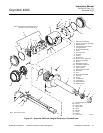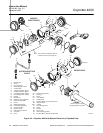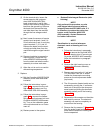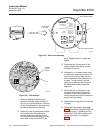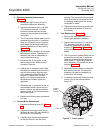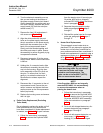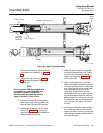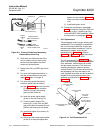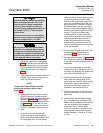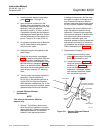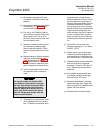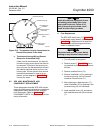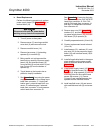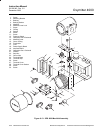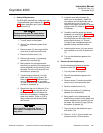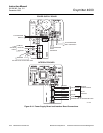
Instruction Manual
IB-106-340 Rev. 3.0
December 2003
Rosemount Analytical Inc. A Division of Emerson Process Management Maintenance and Service 9-15
Oxymitter 4000
Use heat-resistant gloves and clothing
when removing the probe. Do not at-
tempt to work on these components
until they have cooled to room tem-
perature. Probe components can be as
hot as 800°F (427°C). This can cause
severe burns.
Disconnect and lock out power before
working on any electrical components.
There is voltage of up to 115 VAC.
Do not remove the cell unless certain
it needs to be replaced. Removal may
damage the cell and platinum pad. Go
through the complete troubleshooting
procedure to make sure the cell needs
to be replaced before removing it.
1. Follow the instructions in paragraph
9-4a.1 to remove the Oxymitter 4000
from the stack or duct. If removing an
Oxymitter 4000/SPS 4000 assembly,
follow the instructions in paragraph
9-4b.1.
2. If the probe uses the standard diffusion
element, use a spanner wrench to re-
move the diffusion element.
NOTE
To determine if the diffusion element
needs to be replaced, refer to para-
graph 9-2.
3. If equipped with the optional ceramic
diffusion assembly, remove and dis-
card the setscrews and remove the vee
deflector (Figure 9-11). Use spanner
wrenches from the probe disassembly
kit (Table 11-1), to turn the hub free
from the retainer. Inspect the diffusion
element. If damaged, replace the ele-
ment.
4. Loosen the four socket head cap
screws from the cell and flange as-
sembly and remove the assembly and
the corrugated seal. The cell flange
has a notch that may be used to gently
pry the flange away from the probe.
Note that the contact pad inside of the
probe will sometimes fuse to the oxy-
gen sensing cell. If the cell is fused to
the contact pad, push the cell assem-
bly back into the probe (against spring
pressure) and quickly twist the cell as-
sembly. The cell and contact pad
should separate. If the contact pad
stays fused to the cell, a new contact/
thermocouple assembly must be in-
stalled. Disconnect the cell and the
thermocouple wires at the crimp con-
nections and withdraw the cell with the
wires still attached.
5. For units with integral electronics, dis-
connect the entire electronics per
paragraph 9-4c, steps 2 through 5.
6. Remove the four screws (7, Figure 9-3)
from the probe finned housing. The
probe and the probe head can now be
separated.
7. If the contact assembly is damaged,
replace the strut or the contact pad. In-
structions for replacing the contact pad
are in the cell replacement kit.
8. Remove and discard the corrugated
seal. Clean the mating faces of the
probe tube and retainer. Remove burrs
and raised surfaces with a block of
wood and crocus cloth. Clean the
threads on the retainer and hub.
9. Rub a small amount of anti-seize com-
pound on both sides of the new corru-
gated seal.
10. Assemble the cell and flange assem-
bly, corrugated seal, and probe tube.
Make sure the calibration tube lines up
with the calibration gas passage in
each component. Apply a small
amount of anti-seize compound to the
screw threads and use the screws to
secure assembly. Torque to 35 in-lbs
(4 N·m).



